
Marius Jean Antonin Mercié, was a French sculptor, medallist and painter.
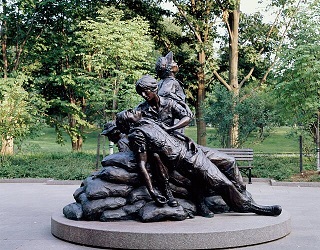
The Vietnam Women's Memorial is a memorial dedicated to the nurses and women of the United States who served in the Vietnam War. It depicts three uniformed women with a wounded male soldier to symbolize the support and caregiving roles that women played in the war as nurses and other specialists. It is part of the Vietnam Veterans Memorial and is located on the National Mall in Washington, D.C., a short distance south of The Wall and north of the Reflecting Pool. The statues are bronze and the base is made of granite. Glenna Goodacre sculpted the memorial after being selected by the United States Commission of Fine Arts and the National Capital Planning Commission, two groups that had previously rejected the idea for a memorial to women.

The British Embassy, Washington D.C. is the British sovereign's diplomatic mission to the United States of America, representing the interests of the United Kingdom and British Government. It is located at 3100 Massachusetts Avenue NW in Washington, D.C. The embassy compound includes the chancery offices, as well as the British Ambassador's residence.

Percy Bryant Baker better known as Bryant Baker, was a British-born American sculptor. He sculpted a number of busts of famous Americans. In 1910, Queen Alexandra of the United Kingdom commissioned him to create a bust of King Edward VII.

Robert Berks was an American sculptor, industrial designer and planner. He created hundreds of bronze sculptures and monuments including the Mary McLeod Bethune Memorial, and the Albert Einstein Memorial in Washington, D.C. Bob was prolific and created numerous sketches, drawings, and paintings; often in service of sculpture and site-planning subjects. He worked for over 50 years in a converted schoolhouse on the north fork of Long Island, NY. For projects with living subjects, Bob would often invite individuals to visit with he and Tod for a period of a week or two so he could observe them in real life; through this time he captured emotions, tendencies, facial expressions, and body language. It was this commitment to understanding his subject below the surface that facilitated the intimacy and personality found in his sculptural portraits. Bob's work is spread around the world, but he is best known for his commissions in Washington DC. Bob is one of the only artists in the world to have multiple pieces regularly on display in the Oval office. Depending on the desires of the sitting US President, Berks' busts of famed civil servants and civil rights leaders line the walls of the Oval ; most often on view are busts of FDR, Lincoln, RFK, Ronald Reagan, and JFK.

The TitanicMemorial is a granite statue in Washington, D.C., that honors the men who gave their lives so that women and children might be saved during the sinking of the Titanic. The idea for a memorial to honor those lost during the tragedy was mentioned quite soon after the sinking. A group of women formed a committee to raise money for a memorial, with a limit of $1 per person. After sending thousands of cards to women throughout the U.S., the committee had raised almost enough funds to complete the project. The federal government paid the remaining amount. A competition was announced for a memorial design and several were submitted. The winning design by Gertrude Vanderbilt Whitney, who would later open the Whitney Museum, would be her first major commission.
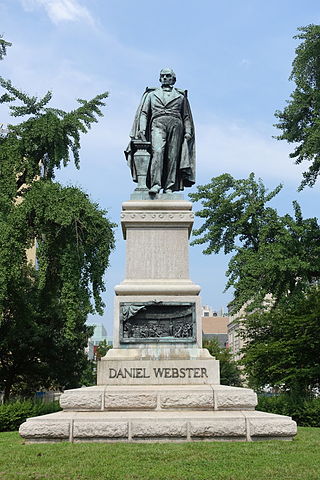
The Daniel Webster Memorial is a monument in Washington, D.C., honoring U.S. statesman and lawyer Daniel Webster. It is located near Webster's former house, beside Scott Circle, at the intersection of Massachusetts Avenue, N Street, and Rhode Island Avenue NW. The person who commissioned the memorial was Stilson Hutchins, founder of The Washington Post, who greatly admired Webster. Congress approved the memorial in 1898 and the dedication ceremony took place in January 1900. Amongst the attendees at the ceremony were President William McKinley and his cabinet, members of Congress, and Supreme Court justices.

The Embassy of Australia in Washington, D.C. is the diplomatic mission of the Commonwealth of Australia to the United States. The chancery is located at 1601 Massachusetts Avenue NW on Scott Circle, at the beginning of Embassy Row. The current ambassador is former Prime Minister Kevin Rudd and the Deputy Head of Mission is Paul Myler. The embassy employs more than 250 people.
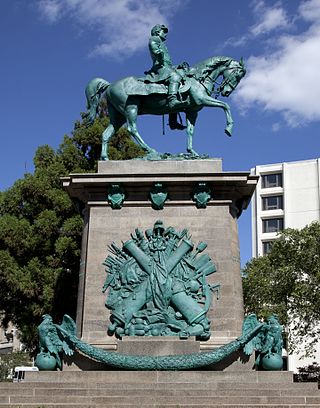
Major General George B. McClellan is an equestrian statue in Washington, D.C. that honors politician and Civil War general George B. McClellan. The monument is sited on a prominent location in the Kalorama Triangle neighborhood due to efforts made by area residents. The statue was sculpted by American artist Frederick William MacMonnies, a graduate of the École des Beaux-Arts whose best known work is a statue of Nathan Hale in New York City. MacMonnies was chosen to design the statue following a lengthy competition organized by a statue commission, led by then Secretary of War William Howard Taft. The monument was dedicated in 1907, with prominent attendees at the ceremony including President Theodore Roosevelt, New York City mayor George B. McClellan Jr., politicians, generals and thousands of military personnel.
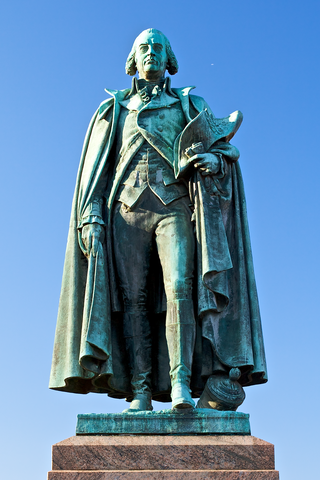
General Artemas Ward is a bronze statue of American Revolutionary War general Artemas Ward. It is sited in the center of Ward Circle, which was specifically made for the statue, at the intersection of Nebraska and Massachusetts Avenue in the American University Park neighborhood of Washington, D.C. The 10-foot (3.0 m) statue of Ward was completed in 1936, but was not unveiled for two years. Ward was the first Commander-in-Chief of colonial forces during the Revolutionary War and served in a number of government roles, including as representative to the United States House of Representatives.

Brigadier General Thaddeus Kościuszko is a bronze statue honoring Polish military figure and engineer Tadeusz Kościuszko. The sculpture was dedicated in 1910, the third of four statues in Lafayette Square, Washington, D.C., to honor foreign-born heroes of the American Revolutionary War. Born in the Polish–Lithuanian Commonwealth in 1746, Kościuszko later received education at a Jesuit school before attending the Corps of Cadets in Warsaw. He later traveled to France where he studied in military academy libraries and adopted views of human liberty during the Age of Enlightenment. He moved to the Thirteen Colonies in 1776, where the war with the Kingdom of Great Britain had already begun. Kościuszko served as an engineer in the Continental Army, earning the praise of his superiors, including General George Washington.

Major General Comte Jean de Rochambeau is a bronze statue honoring Jean-Baptiste Donatien de Vimeur, comte de Rochambeau, a French nobleman and general who played a major role in helping the Thirteen Colonies win independence during the American Revolutionary War. Rochambeau joined the French military as a teenager, participating in the War of Austrian Succession, after which he was promoted to colonel, and the Seven Years' War. During the war in America, Louis XVI asked Rochambeau to lead a force of 5,500 French soldiers to assist the fight against the Kingdom of Great Britain. He and George Washington later worked together in the successful siege of Yorktown. He led the Army of the North during the French Revolutionary Wars, but was arrested and almost executed during the Reign of Terror. His military rank was restored by Napoleon and Rochambeau died a few years later in 1807.

Major General Friedrich Wilhelm von Steuben is a bronze statue of Friedrich Wilhelm von Steuben, a Prussian soldier who assisted the Thirteen Colonies during the American Revolutionary War. Steuben had fought in previous wars, earning promotions until he assisted in the courts of Frederick the Great and later Josef Friedrich Wilhelm, Prince of Hohenzollern-Hechingen. After meeting with Benjamin Franklin, and fearing for his safety in Europe after alleged homosexual behavior, Steuben and his associates arrived to help the Continental Army.

The Embassy of the Republic of Indonesia in Washington, D.C. is the diplomatic mission of the Republic of Indonesia to the United States. It is located at 2020 Massachusetts Avenue, Northwest, Washington, D.C., in the Embassy Row neighborhood. Indonesia has five consulate generals in Chicago, Houston, Los Angeles, New York City, and San Francisco, and an honorary consulate in Honolulu. There is also a permanent mission to the United Nations in New York.

The James Buchanan Memorial is a bronze, granite, and concrete memorial in the southeast corner of Meridian Hill Park, Washington, D.C., that honors U.S. President James Buchanan. It was designed by architect William Gorden Beecher, and sculpted by Maryland artist Hans Schuler. The memorial was commissioned in 1916, but not approved by the U.S. Congress until 1918. The memorial features a statue of Buchanan bookended by male and female classical figures representing law and diplomacy, engraved with text from a member of Buchanan's cabinet, Jeremiah S. Black: "The incorruptible statesman whose walk was upon the mountain ranges of the law."

The Samuel Gompers Memorial is a bronze collection of statues in Washington, D.C., sited on a triangular park at the intersection of 11th Street, Massachusetts Avenue, and N Street NW. Gompers was an English-born American who grew up working in cigar factories, where he witnessed the long hours and dangerous conditions people experienced in factory jobs. He helped with growing the Cigar Makers' International Union, and a few years later, founded the American Federation of Labor (AFL). The number of members rose from 50,000 to 3,000,000 during his time as president of the union. He was not only successful in expanding the power of the labor movement, but also increased its prestige.
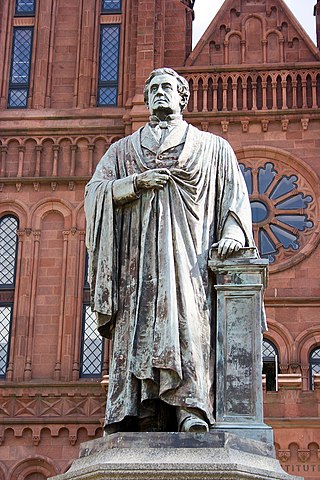
Professor Joseph Henry, also known as the Joseph Henry Memorial, is an outdoor bronze sculpture depicting scientist Joseph Henry, the first president of the Smithsonian Institution. The statue stands in front of the Smithsonian Institution Building in Washington, D.C., facing the National Mall. It was sculpted by artist William Wetmore Story, and dedicated in 1883, a few years after Henry's death. The bronze statue and granite base were unveiled in front of thousands of onlookers and invited guests. Speeches at the dedication included one from Chief Justice of the Supreme Court Morrison Waite, and the president of Yale College, Noah Porter.

William Mozart McVey was an American sculptor, animalier and teacher.

Jacob Epstein's bronze bust of Winston Churchill was completed in 1947 and cast in an edition often said to number 10. Epstein was commissioned by the War Artists Advisory Committee to create a sculpture of former British prime minister Winston Churchill in August 1945, after the end of the Second World War and shortly after Churchill lost the 1945 UK general election. Two casts have been previously displayed in the Oval Office. Another remains on display in the atrium of Churchill College, Cambridge.

The statue of Winston Churchill in Woodford, London, is a bronze sculpture of the British statesman, created by David McFall in 1958–9. The statue commemorates Churchill's role as the member for the parliamentary constituency of Woodford. Churchill was elected to the Epping seat in 1924 and held it until 1945 when the new constituency of Woodford was created. Churchill then held this seat until his retirement in 1964. The statue is a Grade II listed structure.





















